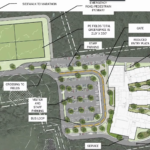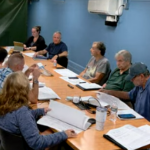It seems unlikely that any of Hopkinton’s statues would face the same fate as those of controversial historical figures across the country — torn down by protesters or removed by local governments and stashed away. Hopkinton’s statues — paying tribute to the World War I doughboy, longtime Boston Marathon starter George V. Brown, inspirational marathoners Rick and Dick Hoyt, and Greek marathon legends Stylianos Kyriakides and Spyridon Louis — would seem unlikely to stir up animosity.
However, there are some prominent Hopkinton names with pasts that include slave ownership (see accompanying story). And then there’s the man for whom the town — as well as a town elementary school — is named, Edward Hopkins.
Hopkins was a wealthy British businessman who traveled to America in 1635 and was one of the founding fathers of Connecticut, serving multiple terms as governor of that state. Late in his life he returned to England, where he died in 1657.
Part of Hopkins’ fortune was donated to Harvard College, which used some of the money to purchase land from Native Americans and rent out plots to English settlers for an annual fee of one penny an acre. Thus was born the town of Hopkinton, which was incorporated in 1715. In 1832 the Massachusetts legislature and Hopkinton residents struck a deal with Harvard, paying a total of $10,000 to have Harvard relinquish its ownership rights.
According to multiple reference sources, Hopkins was a slaveowner — as were many wealthy landowners in New England at that time. In a 2017 article in The Razor, the student newspaper of Connecticut’s Hopkins School (a private school also named for Hopkins, who was its original benefactor) author Elijah Sabin wrote:
“Hopkins was a slaveowner, and when he died in 1657, his estate included an unnamed slave. In Hopkins’ will, ‘the Negar’ was inventoried as property just like Hopkins’ clothes and cows.”
It’s not clear how many slaves Hopkins owned or how they were treated — slaves in the North generally had more rights than Southern slaves but nonetheless were considered property.
School Committee chair Amanda Fargiano said it’s an issue about which she would like to learn more and discuss.
“The Hopkinton School Committee is committed to social justice and working to end racism in our school community,” she wrote via email. “To further underscore this commitment, at the July 9th meeting the School Committee members unanimously voted to adopt the MASC [Massachusetts Association of School Committees] Anti-Racism Resolution. While the school staff and administration oversee resolution of any individual experiences with racism and social injustice, policy level decisions, including the naming of school facilities, are considered by the School Committee. As such, the School Committee will investigate and consider any appropriate action regarding information about the slave-owning history of Edward Hopkins after whom the Hopkins Elementary School is named.”






















0 Comments